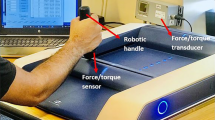Abstract
This article proposes a path-following controller for robotic wheelchairs (RW) used to transport people suffering of severe muscular diseases, taking into account velocity bounds and dynamic effects. A parameterized dynamic model, which considers the person on board the RW, is used. The model parameters normally change, generating structured uncertainties. Moreover, the dynamic model is proposed under some simplifications, introducing unstructured uncertainties. Finally, time-varying dynamics, caused basically by user movements, are also considered. Hence, the dynamic controller proposed is adaptive and robust. Experimental and simulation results show the effectiveness and the good performance of the proposed control system.















Similar content being viewed by others
References
Aström, K. J., & Wittenmark, B. (2008). Adaptive control (2nd ed., Vol. 1). New York: Dover Publication.
Bessa, W. M., & BarrOto, R. S. S. (2010). Adaptive fuzzy sliding mode control of uncertain nonlinear systems. SBA–Controle & Automação, 21(2), 117–126.
Coelho, P., & Nunes, U. (2005). Path-following control of mobile robots in presence of uncertainties. IEEE Transactions on Robotics, 21(2), 252–261.
Cruz, C. D. L., & Carelli, R. (2006). Dynamic modeling and centralized formation control of mobile robots. In 32nd Annual conference of the IEEE industrial electronics society IECON (pp. 3880–3885). Paris
Cruz, C. D. L., Carelli, R., & Bastos, T. F. (2011a). Adaptive control law for robotic wheelchairs. IFAC–Control Engineering Practice, 19(2), 113–125.
Cruz, C. D. L., Celeste, W. C., & Bastos, T. F. (2011b). A robust navigation system for robotic wheelchairs. IFAC–Control Engineering Practice, 19(6), 575–590.
de Wit, C. C., Siciliano, B., & Bastin, G. (1997). Theory of robot control. London: Springer-Verlag.
Ding, D., & Cooper, R. A. (2005). Electric-powered wheelchairs: A review of current technology and insight into the future directions. IEEE Transactions on Neural Networks, 1(1), 22–34.
Do, K. D., Jiang, Z. P., & Pan, J. (2004). Simultaneous tracking and stabilization of mobile robots: An adaptive approach. IEEE Transactions on Automatic Control, 49(7), 1147–1151.
dos Santos, F. P. N. (2011). Robotizatpo de uma cadeira de rodas. Master’s thesis, Universidade Federal do Espírito Santo, Vitória. Brasil: ES.
Fierro, R., & Lewis, F. L. (1997). Control of a nonholonomic mobile robot: Backstepping kinematics into dynamics. Journal of Robotics Systems, 14(3), 149–163.
Fioretti, S., Leo, T., & Longhi, S. (2000). A navigation system for increasing the autonomy and the security of powered wheelchairs. IEEE Transactions on Rehabilitation Engineering, 8(4), 490–498.
Isidori, A. (1989). Nonlinear control systems (1st ed., Vol. 1). Berlin: Springer-Verlag.
Jordan M. A., & Bustamante J. L. (2008). A totally stable adaptive control for path tracking of time-varying autonomous underwater vehicles. Proceedings of 17th IFAC World Congress, 17(1), 15985–15990.
Kim, C. H., Jung, J. H., & Kim, B. K. (2004). Design of intelligent wheelchair for the motor disabled (pp. 299–310). Daejeon: Proceedings of the Eighth International Conference on Rehabilitation Robotics.
Martins, F. N., Celeste, W. C., Carelli, R., Filho, M. S., & Filho, T. F. B. (2008). An adaptive dynamic controller for autonomous mobile robot trajectory tracking. IFAC–Control Engineering Practice, 16(11), 1354–1363.
Parikh, S. P., Grassi, V., Kumar, V., & Okamoto, J. (2007). Integrating human inputs with autonomous behaviors on an intelligent wheelchair platform. IEEE Transactions on Intelligent Systems, 22(2), 33–41.
Patre, P. M., MacKunis, W., Makkar, C., & Dixon, W. E. (2008). Asymptotic tracking for systems with structured and unstructured uncertainties. IEEE Transactions on Control Systems Technology, 16(2), 373–379.
Sastry, S., & Bodson, M. (1989). Adaptive control: Stability, convergence, and robustness (Vol. 1). Portland, OR: Dover Publications.
Slotine, J.-J., & Li, W. (1988). Adaptive manipulator control: A case study. IEEE Transactions on Automatic Control, 33(11), 995–1003.
Soetanto, D., Lapierre, L., & Pascoal, A. (2003). Adaptive, non-singular path-following control of dynamic wheeled robots. Proceedings of the 42nd IEEE conference on decision and control. Maui, Hawaii, USA.
Strang, G. (1988). Linear algebra and its applications (3rd ed., Vol. 1). New York: Thomson Learning, Inc.
Tanner, H. G., & Kyriakopoulos, K. J. (2003). Backstepping for nonsmooth systems. Automatica, 39(7), 1259–1265.
Vargas, J. A. R., & Hemerly, E. M. (2008). Observação adaptativa neural com convergência assintótica na presença de parâmetros variantes no tempo e distubios. SBA–Controle & Automação, 19(1), 18–29.
Acknowledgments
The authors thank CAPES (Brazil) and SPU (Argentina) for funding the partnership between Federal University of Espirito Santo/Brazil and National University of San Juan/Argentina (Project 018/04 CAPG-BA), and FAPES (Brazil) for financing part of this study (Process: 39385183/2007). Mr. Celeste also thanks CNPq, a Brazilian institution that supports scientific and technical development, for the scholarship he received for his Ph. D. research.
Author information
Authors and Affiliations
Corresponding author
Rights and permissions
About this article
Cite this article
Celeste, W.C., Bastos-Filho, T.F., Sarcinelli-Filho, M. et al. A Robust Adaptive Path-Following Controller for a Robotic Wheelchair. J Control Autom Electr Syst 24, 397–408 (2013). https://doi.org/10.1007/s40313-013-0052-z
Received:
Revised:
Accepted:
Published:
Issue Date:
DOI: https://doi.org/10.1007/s40313-013-0052-z




